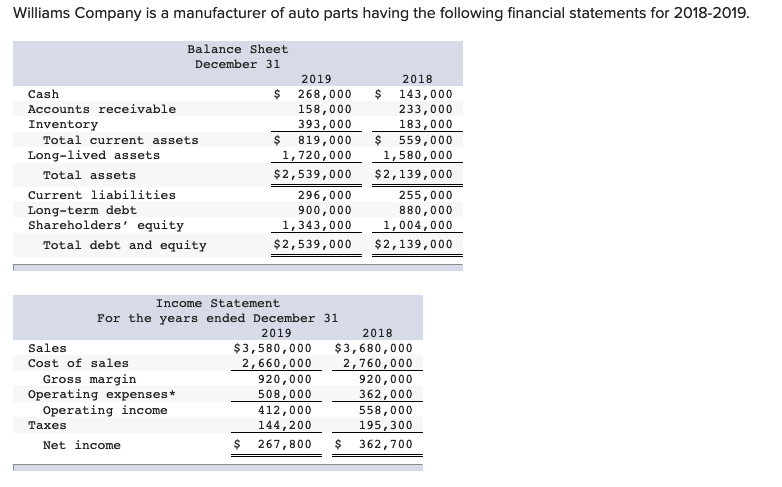Williams Company is a manufacturer of auto parts having the following financial statements for 2018-2019.



Required: Develop a business valuation for Williams Company for 2019 using the following methods: (1) book value of equity, (2) market value of equity, (3) discounted cash flow (DCF), (4) enterprise value, and (5) all the multiples-based valuations for which there is an industry average multiplier. For the calculation of the DCF valuation, you may use the simplifying assumption that free cash flows will continue indefinitely at the amount in 2019.

Williams Company is a manufacturer of auto parts having the following financial statements for 2018-2019 Balance Sheet December 31 2019 2018 Cash Accounts receivable Inventory $ 268,000 143,000 233,000 393,000183,000 $ 819,000 559,000 158,000 Total current assets Long-lived assets 1720,0001,580,000 Total assets Current liabilities Long-term debt Shareholders' equity $2,539,000 296,000 900,000 1,343,000 $2,539,000 $2,139,000 255,000 880,000 1 , 004 , 000 $2,139,000 Total debt and equity Income Statement For the years ended December 31 2019 2018 Sales Cost of sales $3,580,000 $3,680,000 2,760,000 920,000 362,000 558,000 195,300 $ 267,800 $ 362,700 2,660,000 Gross margin 920,000 508,000 412,000 144,200 Operating expenses* Operating income Taxes Net income Cash Flow from Operations 2019 2018 Net income Plus depreciation expense + Decrease (-increase) in accounts receivable and inventory + Increase (-decrease) in current liabilities s 267,800362,700 90,000 100,000 (135,000) 41,000 Cash flow from operations $ 273,800 452,700 Operating expenses include depreciation expense. Additional financial information, including industry averages for 2019, where appropriate, includes Industry 2019 2019 2018 Capital expenditures Income tax rate Depreciation expense Dividends Year-end stock price Number of outstanding shares Sales multiplier Free cash flow multiplier Earnings multiplier Cost of capital Accounts receivable turnover Inventory turnover Current ratio Quick ratio Cash flow from operations ratio Free cash flow ratio Gross margin percent Return on assets (net book value) Return on equity $ 105,000 180,000 35% 35% 35.0% $ 100,000 $ 90,000 $42,000 42,000 25.00 1,880,000 1,880,000 8800503S 1.50 18.00 9.00 11.10 10.50 2.30 1.90 1.20 1.10 30. 0% 20.0% 30.0% Required Develop a business valuation for Williams Company for 2019 using the following methods: (1) book value of equity, (2) market value of equity, (3) discounted cash flow (DCF), (4) enterprise value, and (5) all the multiples-based valuations for which there is an industry average multiplier. For the calculation of the DCF valuation, you may use the simplifying assumption that free cash flows will continue indefinitely at the amount in 2019 Required Develop a business valuation for Williams Company for 2019 using the following methods: (1) book value of equity, (2) market value of equity, (3) discounted cash flow (DCF), (4) enterprise value, and (5) all the multiples-based valuations for which there is an industry average multiplier. For the calculation of the DCF valuation, you may use the simplifying assumption that free cash flows will continue indefinitely at the amount in 2019. Book value of equity Market value of equity Discounted free cash flows Enterprise value Multiples-based valuation Earnings multiple Free cash flow multiple Sales multiple










